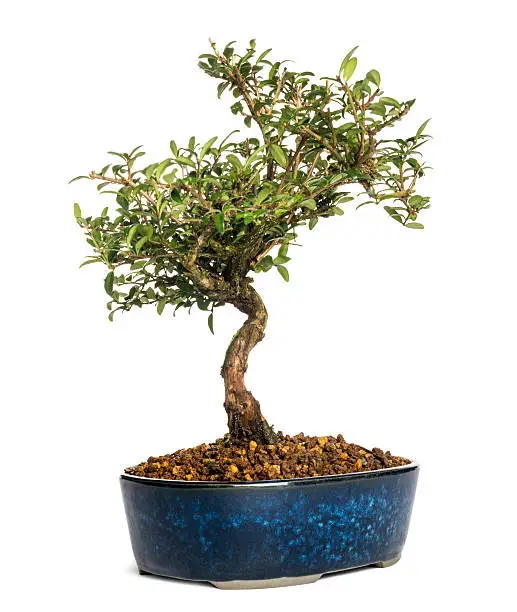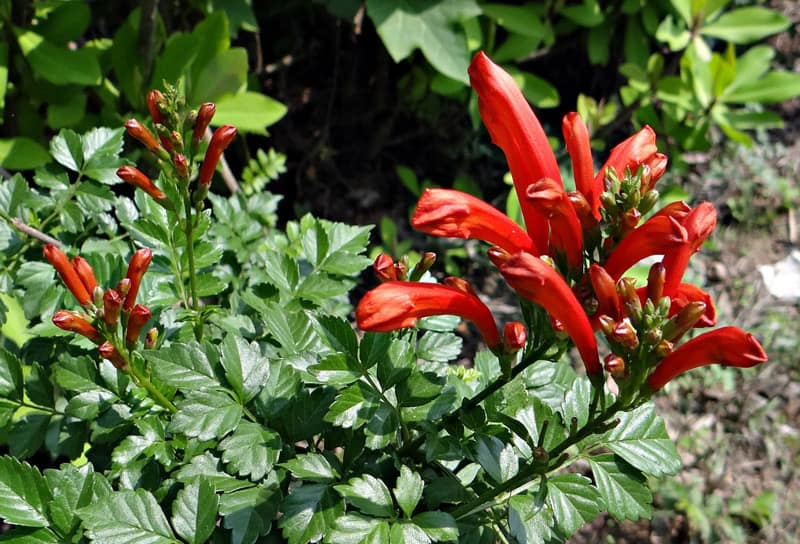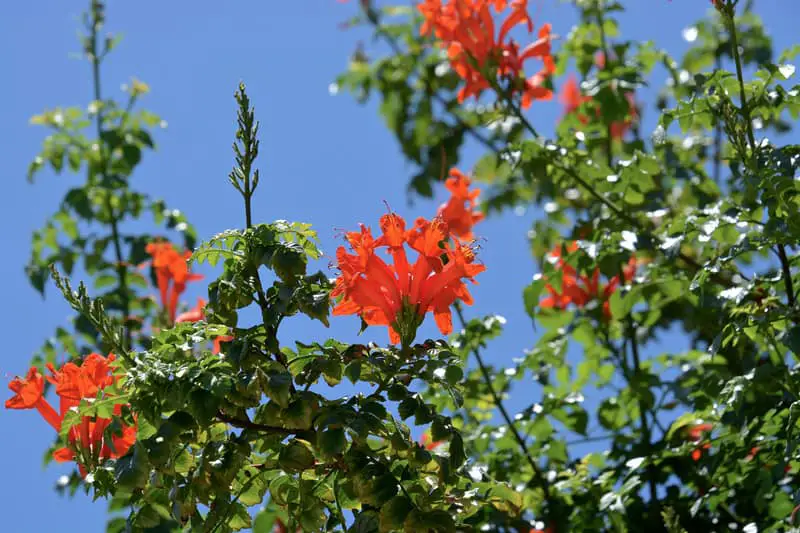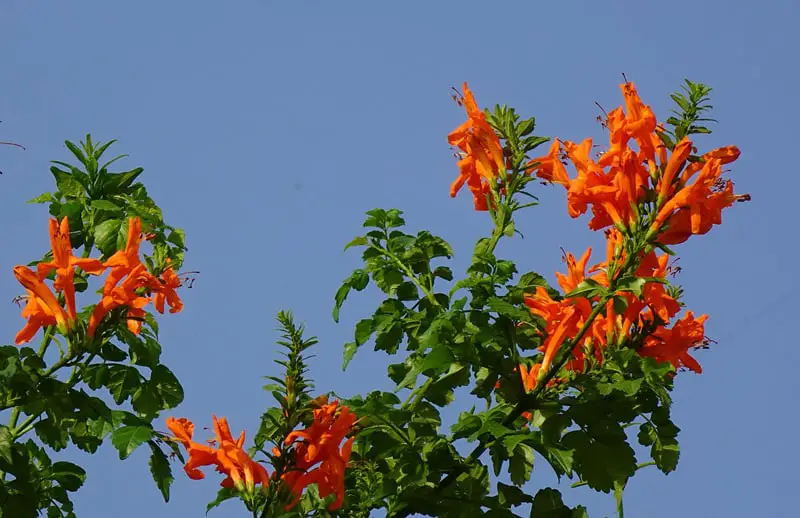Table of Contents
The Cape Honeysuckle is evergreen shrubby plant renown for its trumpet-shaped flowers blossoming in different colors ranging from apricot, orange, yellow, and red. The tree is a fast grower and can grow up to 33cm in its first planting year after spring. They can be easily maintained and will make an excellent Bonsai specimen with proper care.

In this Cape Honeysuckle bonsai care guide, I will be sharing useful tips on how you can train this interesting tree in line with the best Bonsai practices. Read on to grasp full details!
| Scientific Name | Tecoma capensis |
| Family | Asteraceae |
| Average Height | 2.50 to 6.00 feet |
| Average Spread | 1.00 to 1.25 feet |
| Origin Countries | South Africa |
| Flower Bloom Time | May to September |
| Water | Wet |
| Sunlight | Full Sun |
| Maintenance | Medium |
Can we Bonsai Cape Honeysuckle?
Yes, you can Bonsai a Cape Honeysuckle tree. Apart from requiring low maintenance to grow vivaciously and healthily, they are fast-growing plants that can be grown both indoors and outdoors for as long as they can receive enough sunlight wherever they are placed.
If you are new to the art of Bonsai, the Cape Honeysuckle is the ideal tree for you to start with as they require minimal effort to grow.
Cape Honeysuckle Bonsai History

The Cape honeysuckle plant is native to tropical Southern Africa. After the tree was discovered, it was used worldwide for ornamental purposes. In countries like Cuba, New Zealand, and Australia, the tree is considered invasive because it can also be found in those regions in large numbers even though they are not its natural habitat.
Cape Honeysuckle Bonsai scientific name

The scientific name of Cape Honeysuckle is Tacoma capensis
Cape Honeysuckle Bonsai care
Cape Honeysuckle is one easy plant to grow and requires little effort for successful cultivation, but regardless, one must make sure that they are adequately fed with the needed nutrients, water and appropriately placed before they can grow to become the tree of our desire.
Check below for details on how you can treat your Cape Honeysuckle in the best possible way.
Cape Honeysuckle Bonsai Temperature
The Cape Honeysuckle is a Tropical tree that can survive in hardiness zones 9-11. They can tolerate both heat and drought, however, if they are exposed to a temperature level below 25 degrees Fahrenheit, they are likely to lose their leaves and branches.
Cape Honeysuckle Bonsai Fertilizer
You should lightly fertilize your Cape Honeysuckle Bonsai frequently during its active seasons to maintain its blooms. This should be done all through the seasons till the plant reaches its dormant period (winter) when they are usually taken inside to protect them against extreme cold.
It is best to fertilize your Cape honeysuckle Bonsai with a balanced fertilizer diluted to half its strength. Or if an organic fertilizer comes in handy to you, top-dress your Cape Honeysuckle with compost at the onset of a new growing season.
Cape honeysuckle Bonsai Pruning
Dense leaves are not good for a Bonsai tree, whenever you noticed your Cape honeysuckle leaves are growing too dense, trim them back to 1 pair. If you desire for your Cape honeysuckle to grow flowers, allow the tree to keep growing until new flower buds are becoming more noticeable.
If you chose to heavily prune the tree to the woods, you can go ahead as the tree can absorb the shock, and trust me, they will bounce back in the next growing season with fresh new buds and leaves.
Cape Honeysuckle Bonsai wiring
You should know that it is usually very difficult to bend fully grown branches of a Cape Honeysuckle tree: therefore, the best time to wire your plant would be immediately after pruning or at the early growth stage of the tree.
Cape honeysuckle Bonsai Repotting
The best time to repot a Cape honeysuckle Bonsai is early spring as it is returning from dormancy. It is appropriate to repot your tree at this period in readiness for the next growing season. If you repot your Cape honeysuckle Bonsai during in summer, your tree may have stunted growth; which is not a trait commonly seen with the tree species.
Cape honeysuckle responds well to root-pruning, however, when it is excessively done, it will cause them to suffer and may take time before they eventually recover. When transplanting, make use of soil mix comprising of 60% aggregate (decomposed granite, diatomite, & agricultural pumice) and 40% organic matter.
Cape Honeysuckle Pests and Diseases
The Cape honeysuckle tree is commonly affected by insects like Aphids & Scales as well as other infections caused by fungi and leaf burn. Check below for details about these infections.
Leaf burn
Leaf burn also known as leaf scorch turns the leaves of Cape honeysuckle from green to yellow and then to brown if the infection is left untreated. At first, the infection may only be apparent on the tips of the leaves, but as it spreads further, the leaves will turn completely black, shrink and start to fall off the tree. This is usually regarded as an abiotic problem; meaning “not alive”.
Frost, wind, soil, or mineral deficiencies and excessive sunlight are usually the major cause of leaf burn. Check the condition under which your Cape honeysuckle is being raised and make necessary adjustments as needed to save your tree.
Aphids and Scales
Aphids and Scales attack the Cape honeysuckle tree occasionally and when they do, they go in for the kill. These insects suckle the juice produced by the plant’s foliage and vulnerable new growths. As they suck on the tree’s juice, they reduce the tree’s vital liquids, and this could lead to brown spots or blotches on the leaves or deform the tree, or may cause the plant to drop its leaves earlier than usual.
At times, these insects could discharge honeydew, a sticky material that can encourage the growth of sooty mold. If the growth of these sooty molds is not curbed, it will affect the tree’s ability to photosynthesize.
To remedy the damage caused by this insect and get rid of them for good, Flush off the insects with hard spray focusing on the upper and lower part of the leaves. You can follow up with insecticidal soap or horticultural spray to kill insects and infections that are persistent. Use the spray regularly until the tree becomes insect-free.
Fungal infections
Fungal infections lead to brown blotches that can merge and spread further until the entire leaves turn brown. This may cause the leaves too for the back or cause the leaves to fall earlier than usual. Your best bet at curbing this infection is by trimming all affected leaves and riding the garden of all leaf debris and making sure to sanitize all tools after use.
Apply fungicide or a copper spray on the treated spots or they can also be used as preventive measures depending on what kind of fungus attacking your tree.
Cape Honeysuckle Bonsai soil
Cape Honeysuckle Bonsai is a tropical plant, and therefore, must be planted in a soil mix of 60% aggregate to 40% organic matter. This mixture will provide a perfect ground for your tree to germinate. Keep the soil moist always but avoid creating waterlog so that the tree will not suffer root rot.
Cape honeysuckle Bonsai watering
You must water Cape honeysuckle regularly because the soil must stay moisturized most times, yet they must be kept under full sun. The most important thing here is keeping them moist always and protecting them from totally drying out.
Cape honeysuckle Bonsai sunlight
Cape honeysuckle needs at least 6 hours of full sunlight daily for healthy growth. Afternoon shade will impact positively on their growth as well.
Cape honeysuckle Bonsai types

There are 3 main varieties of the true honey cycle which are; Aurea, Coccinea, and Salmonea. But the Cape honeysuckle is of two major types: Cape honeysuckle Arizona, and Tecomaria Cape honeysuckle. Check below for a brief description of the two major types.
Cape honeysuckle Arizona
The Cape honeysuckle Arizona (Tacoma caopensis) is a scrubby desert plant perfect for the Arizona climate.
This tree is known for its dark, thick leaves and beautiful orange-colored flowers that blossom year-round. The tree can grow up to 3-9 feet in height. They are growing well in gull sun easy to maintain and they grow very fast. Cape honeysuckle is frost hardy as long as the temperature does not drop below 28 degrees, anything below that will cause the tree to suffer frost damage.
Tecomaria Cape honeysuckle
The Tecomaria Cape honeysuckle is a beautiful ornamental garden tree. This tree is mostly used for decorative and screening purposes and can also be pruned to shape as a hedge. Like another false Cape honeysuckle, the Tecomaria tree is also a fast-growing plant that can grow up to 2 – 3m high and can spread across 2.5m.
The evergreen tree is a find of warm climate that loses its leaves when exposed to extreme cold weather. The flowering style of the tree is erratic and blossoms flower all year round.
If you are a fan of flowering bonsai, you may want to learn more on bonsai flame tree, camellia bonsai, pittosporum bonsai, honeysuckle bonsai, amelanchier bonsai, hibiscus syriacus bonsai, chrysanthemum bonsai, japanese wisteria bonsai and adenium obesum bonsai too.
Cape honeysuckle Bonsai common problem
The problems commonly faced by Cape honeysuckle Bonsai growers are Nutritional problems and watering problems. Check below for detailed explanations about these problems.
Nutritional problems
When your Cape honeysuckle is malnutrition, it will suffer from Chlorosis (fading); and if left untreated for a long time, it may lead to Necrosis (death).
If your Cape honeysuckle is malnutrition, it is likely caused by the lack of either nitrogen, manganese, zinc, or iron in the soil or something that is preventing your tree from making use of the nutrients present in the soil. Root rot, insects, and soggy soil may affect the ability of your tap nutrients from the soil to make optimal use of them to develop.
Malnutrition may lead to stunted growth, discoloration, or cause the branches and leaves of your tree to dieback. If your tree is malnutrition, you should fertilize them, but make use of slow-released fertilizers so you don’t get it over-fertilized. If the soil has a high pH, accessing magnesium and iron may become problematic for the tree, make adjustments as needed.
To keep your Cape honeysuckle tree healthy, make use of foliar sprays together with fertilizers because leaves nutrients get to them faster than when you fertilize just the soil.
Adequate watering
For Cape honeysuckle to produce flowers, it has to be adequately watered. When I said adequate, I mean striking a balance between overwatering and underwatering The tree needs to be watered thoroughly at least once a week but during the dry season, you should water them less.
You should ensure the soil used encourages drainage and if you notice the leaves of your tree are turning brown, check for root rots as that may be the possible cause. Although underwatering can also cause the leaves to discolor, wither, and fall quicker than expected.
Cape honeysuckle can tolerate drought to some extent, will go several weeks without enough water, however, because the tree needs to be under the sun, the soil may dry out frequently between watering and rainfall. To make up for the deficit so that it doesn’t affect the smooth growth of the tree, increase irrigation.
Why is my Cape honeysuckle Bonsai, not flowering?
If your Cape honeysuckle is not flowering as it should, it might be as a result of the following 6 reasons.
- Lack of sufficient nutrients in the soil.
- You are raising your tree under inadequate sunlight.
- You left the soil to dry out for a long time.
- You pruned the tree too heavily or you pruned at the wrong time.
- You have over-fertilized your tree, and therefore, it is growing more leaves instead of flowers.
- You are being impatient because Cape honeysuckle won’t flower until it matures and that is most likely to happen when it is about 3 years old.
Cape honeysuckle root system
Normally, Cape honeysuckle propagates itself naturally through layering. As the stems of Cape honeysuckle touches the ground in its growing season, roots start to form at the spots on the stems where new leaves are to grow. Roots develop together with top growth during summer.
Do Cape honeysuckle Bonsai grow fast in pots?
Cape honeysuckle is a fast-growing plant, and therefore, it doesn’t matter whether you are planting it in a pot or the ground, they will grow fast.
Does Cape honeysuckle Bonsai smell good?
Yes, Cape honeysuckle smells nice however, the Tecoma variant is not fragrant.
Does honeysuckle Bonsai attract bees?
Yes, the flower nectars of Cape honeysuckle attract butterflies, hummingbirds, and bees.
Is Cape honeysuckle Bonsai poisonous to dogs?
No, cape honeysuckle (Tecoma capensis) is not poisonous to pets. However, the true honeysuckle is considered highly toxic for dogs, birds, and cats. Although they are not toxic to humans.
How to get Cape honeysuckle Bonsai to bloom.
To get your Cape honeysuckle Bonsai to bloom, fees your tree with a bone meal during its growing season.
![Pittosporum Bonsai [Pittosporum Tobira]](https://www.bonsai-express.com/wp-content/uploads/2022/05/Pittosporum-Bonsai-365x200.jpg)
![Sorbus Bonsai [Sorbus Aucuparia]](https://www.bonsai-express.com/wp-content/uploads/2022/05/Sorbus-Bonsai-365x200.jpg)
![Tsuga Bonsai [Tsuga Canadensis]](https://www.bonsai-express.com/wp-content/uploads/2022/05/Tsuga-Bonsai-365x200.jpg)
![Tamarix Bonsai [Tamarix Ramosissima]](https://www.bonsai-express.com/wp-content/uploads/2022/05/Tamarix-Bonsai-365x200.jpg)